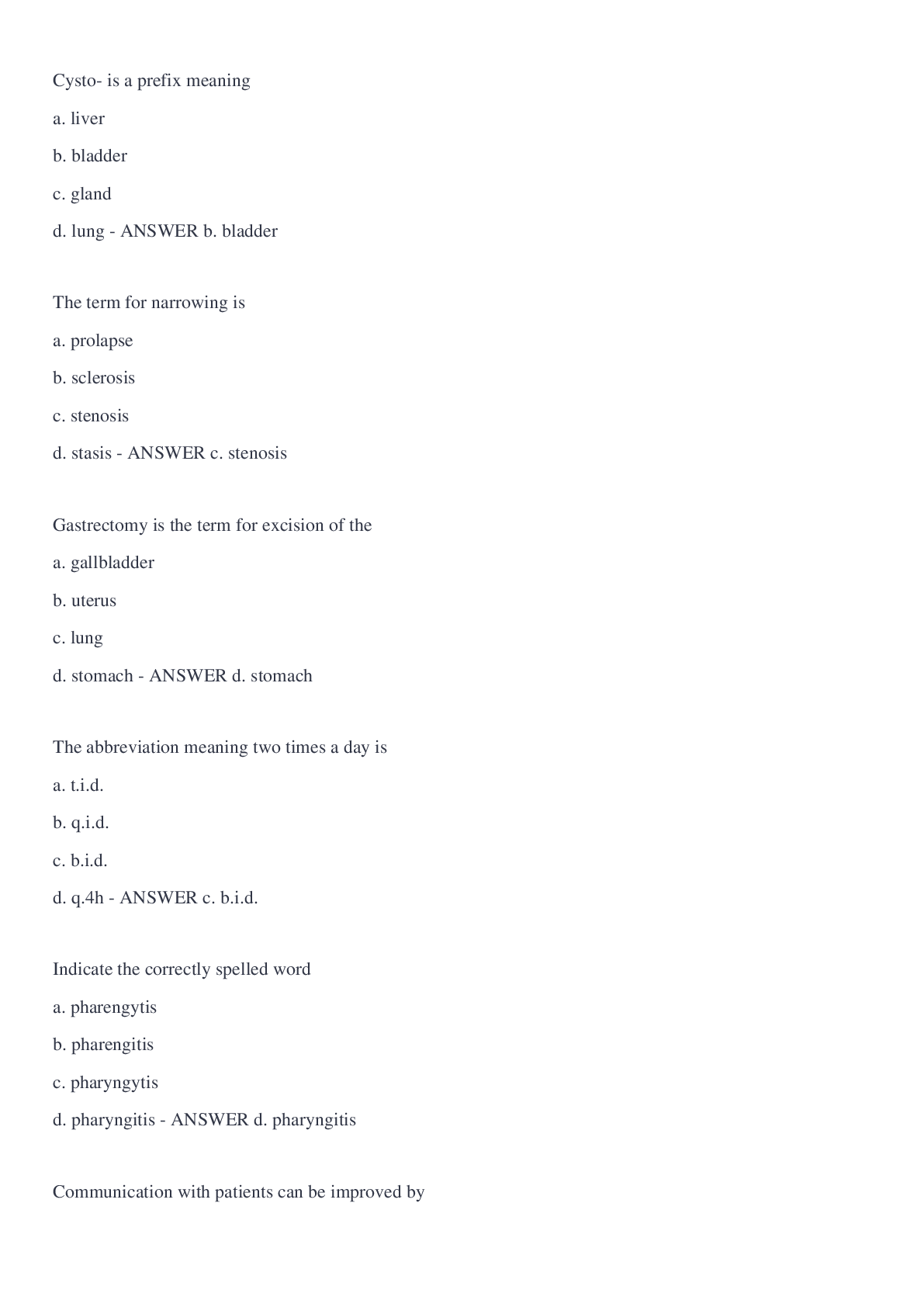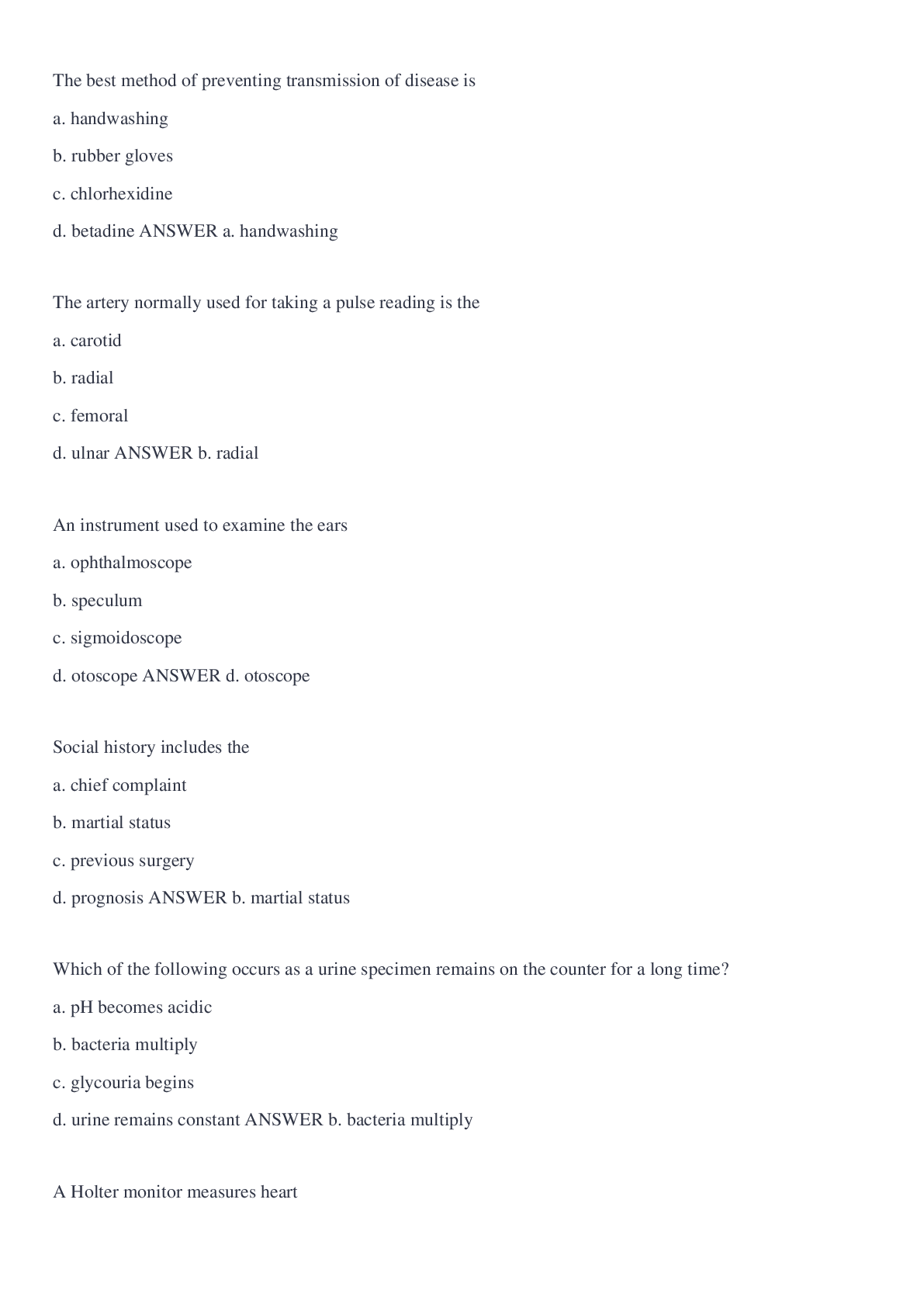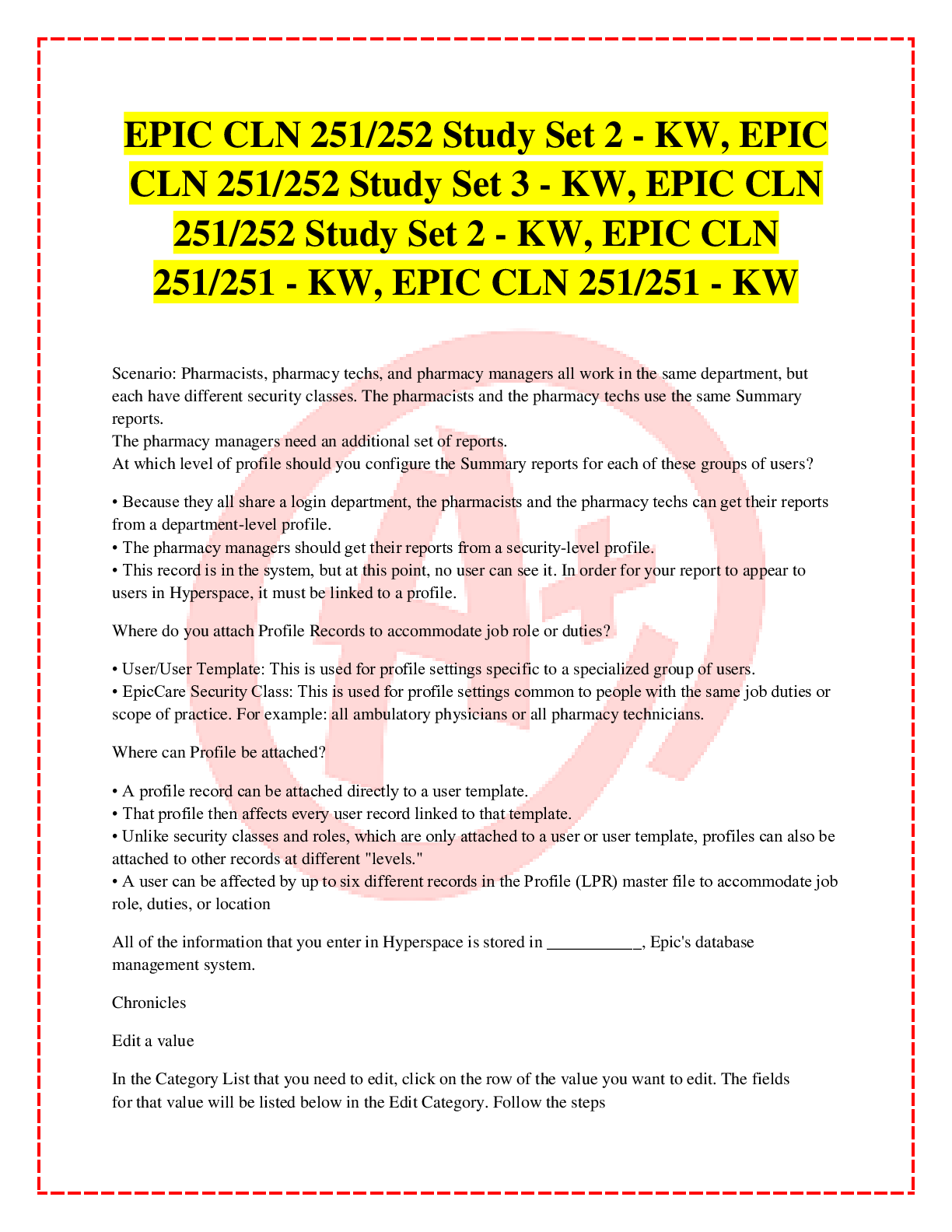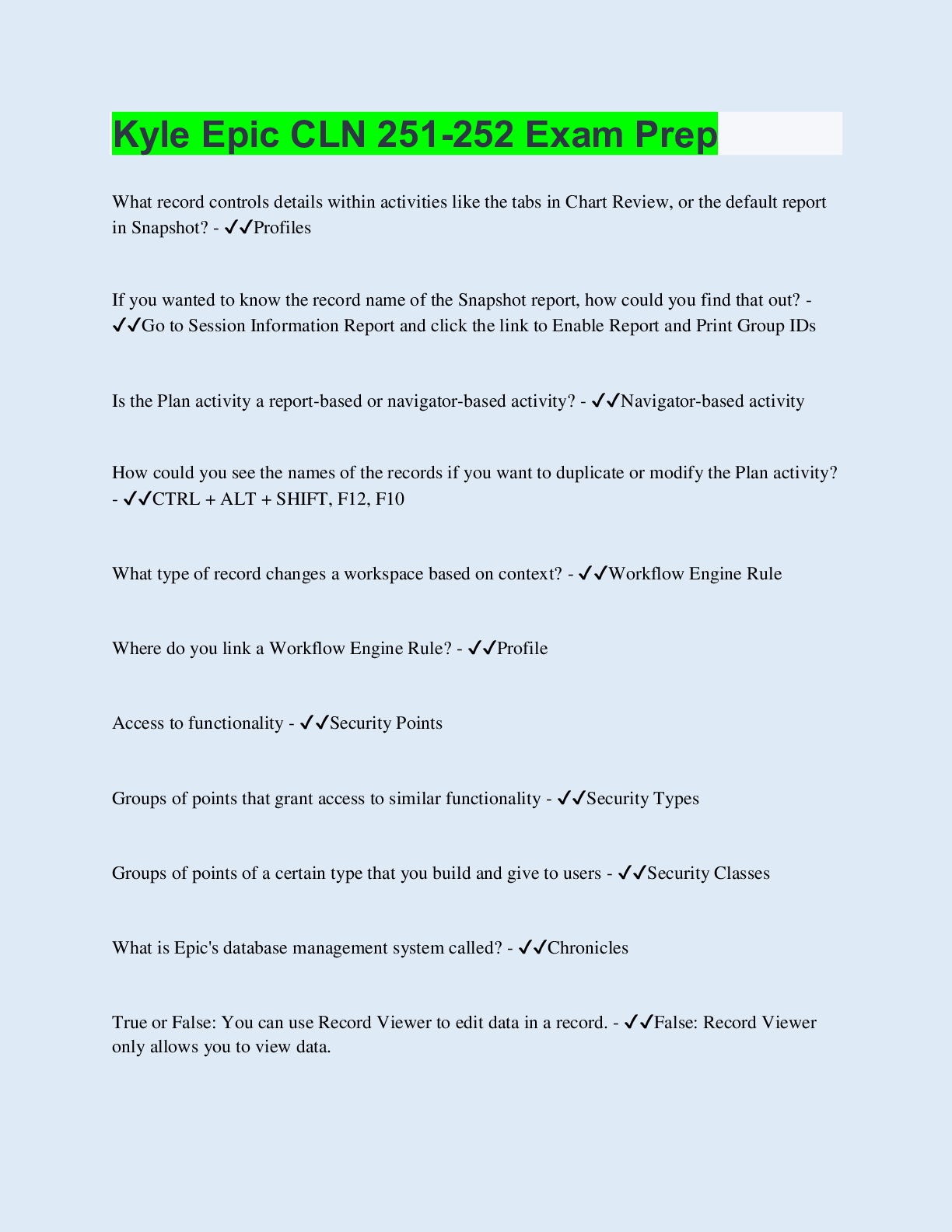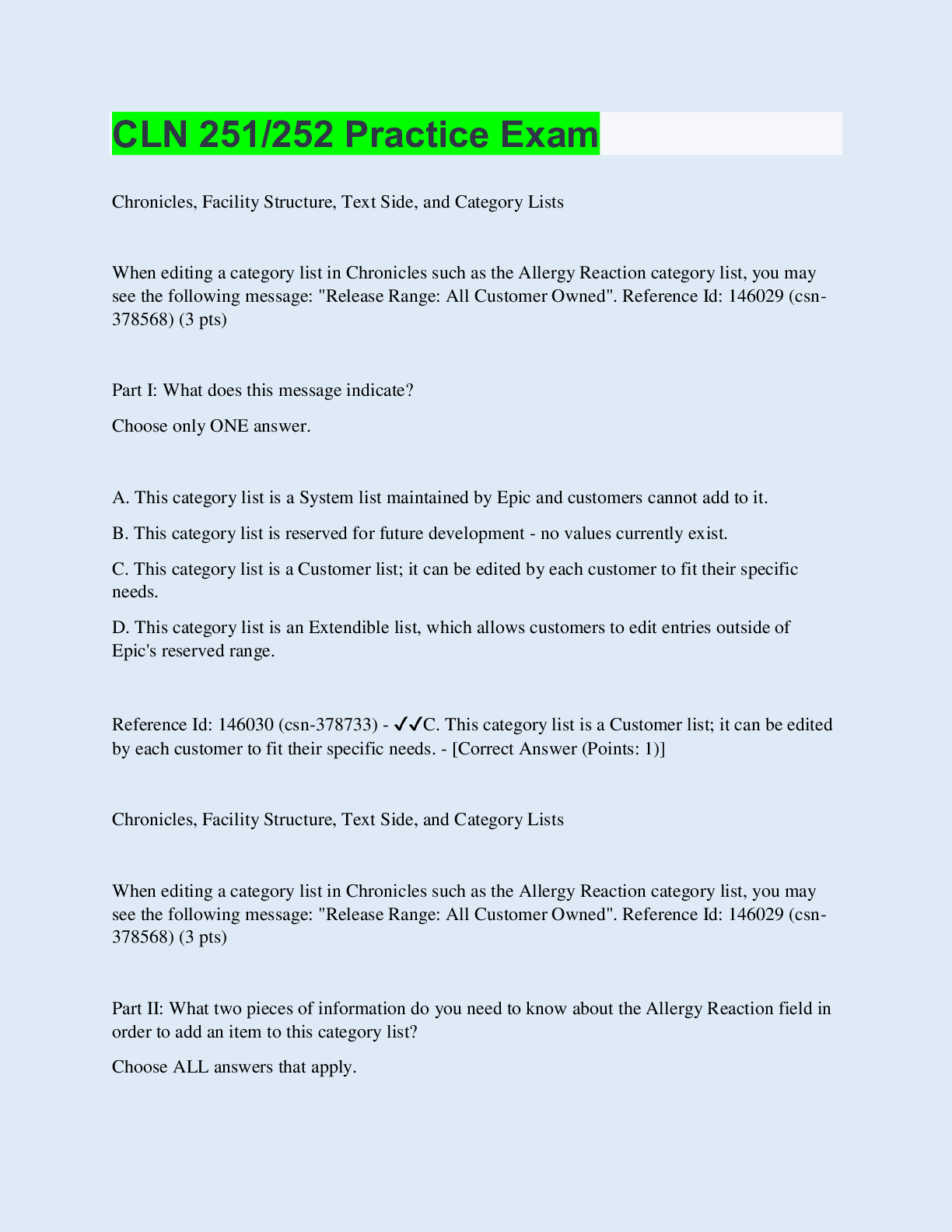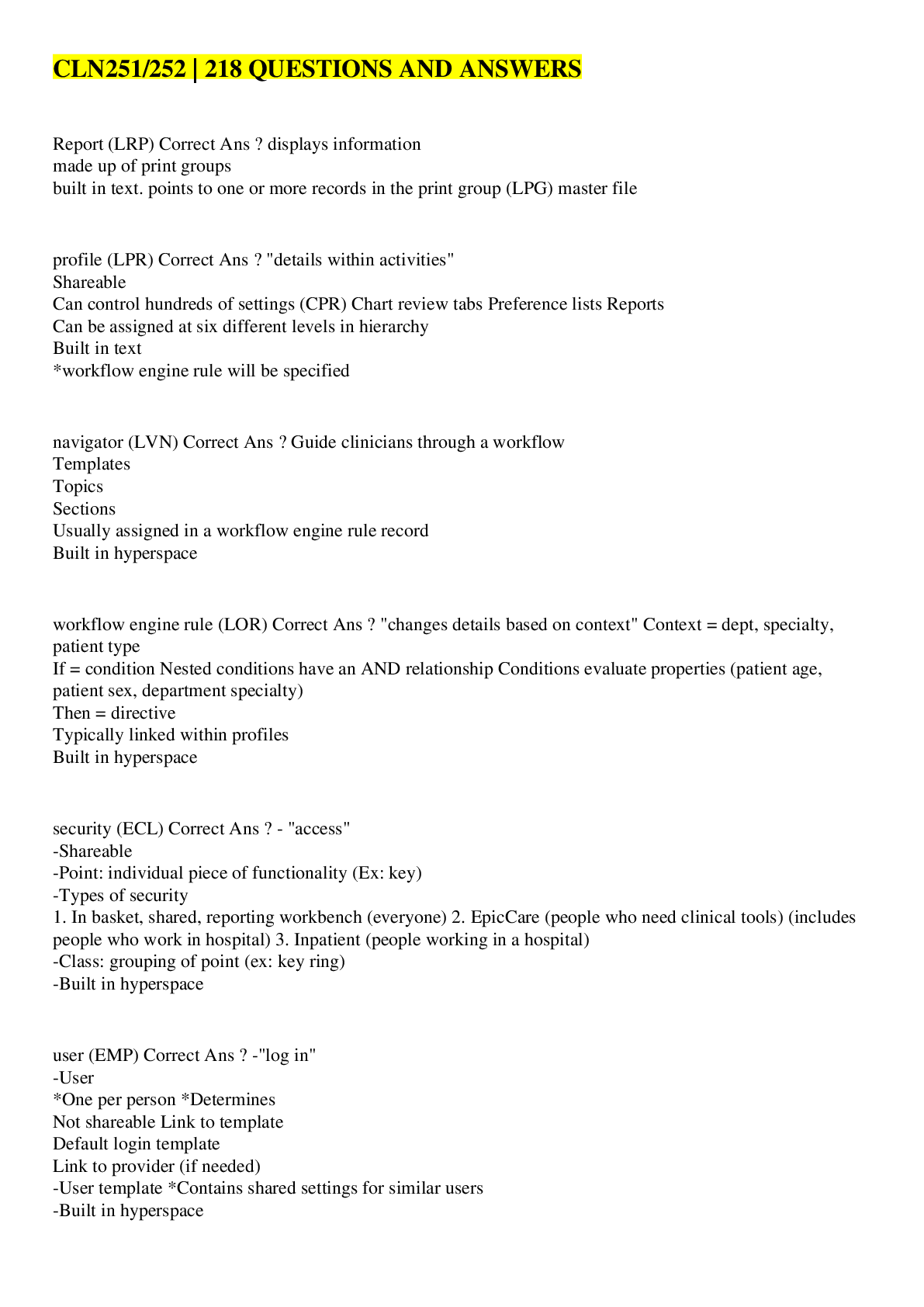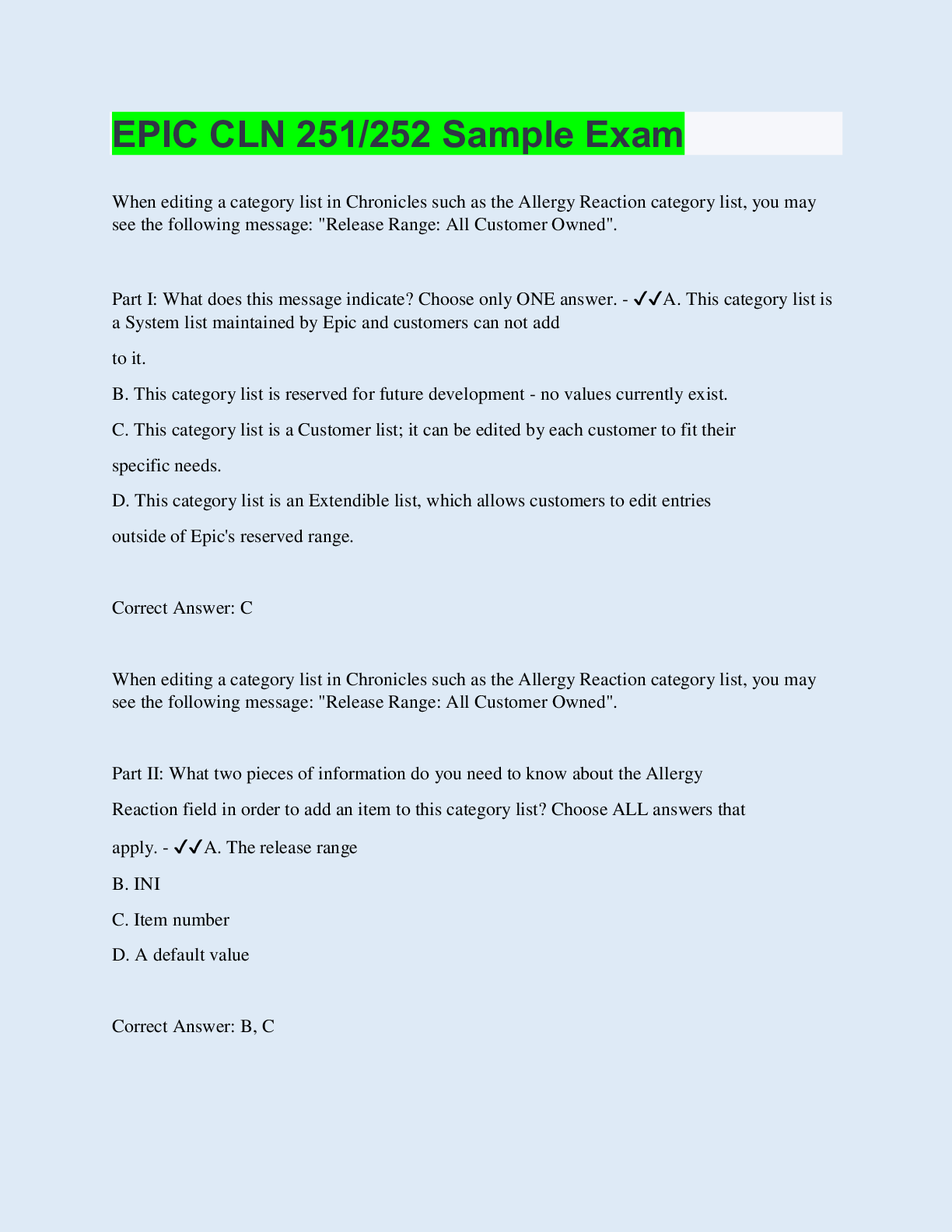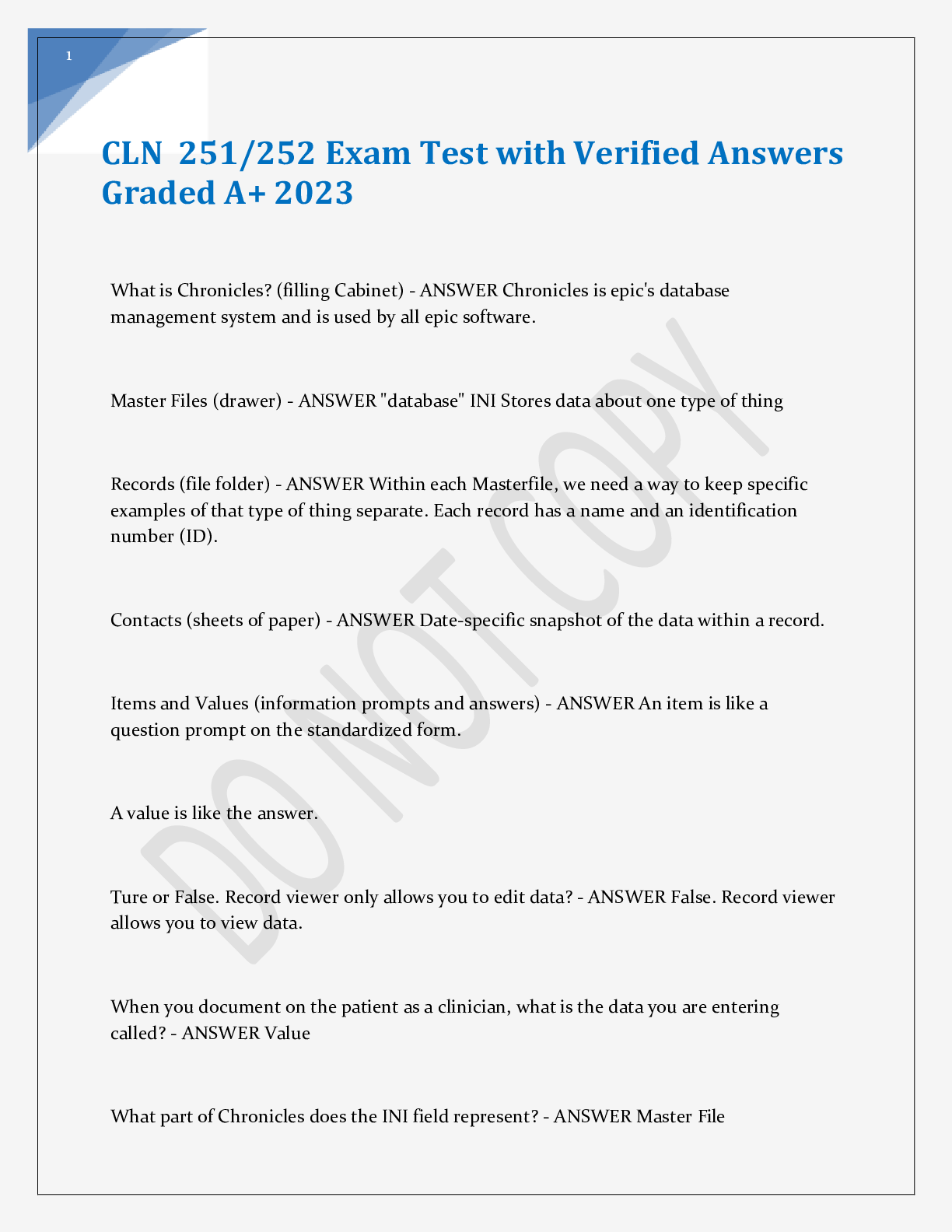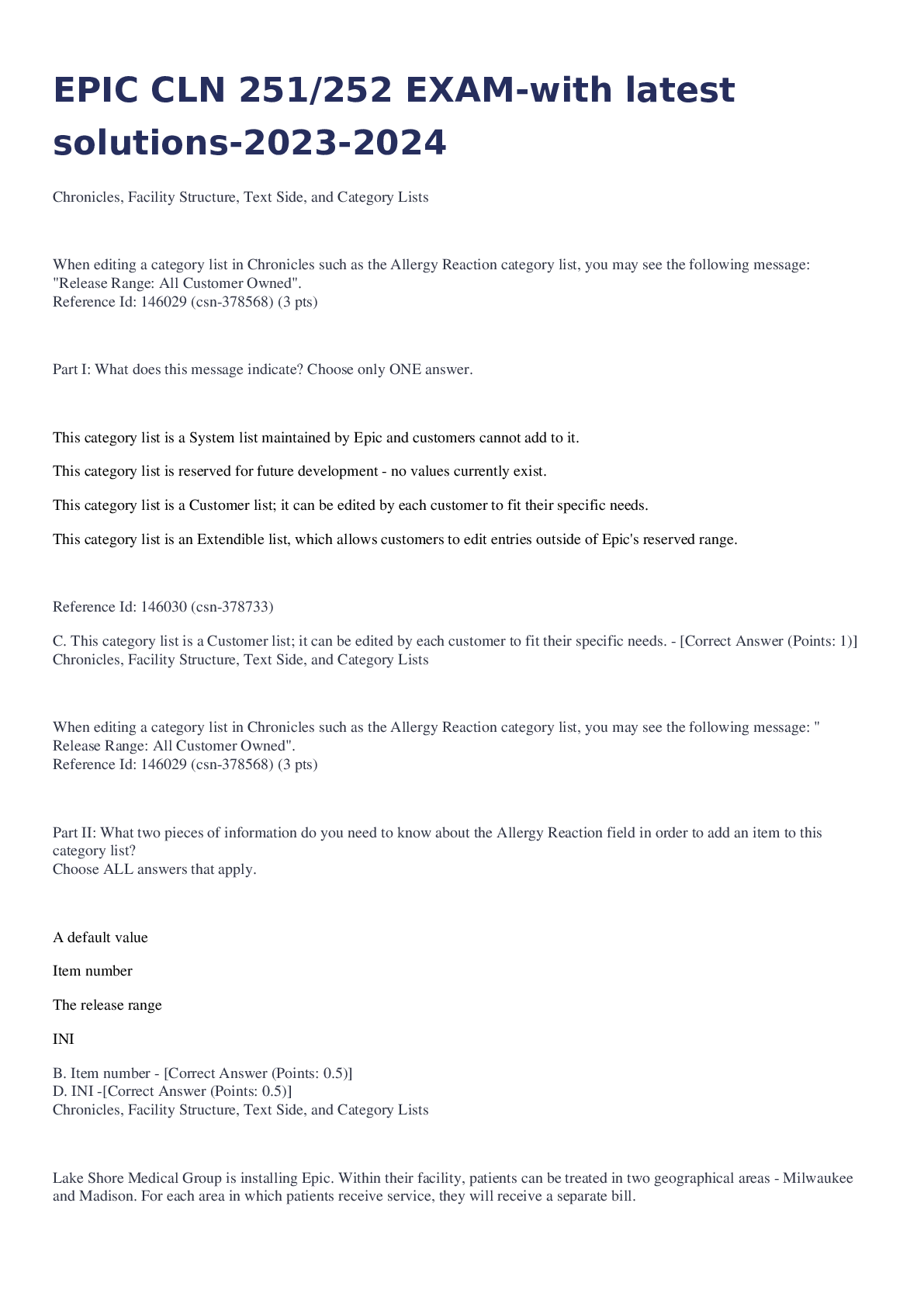American Red Cross-ACLS-Final Exam 2022
Document Content and Description Below
A patient is in cardiac arrest. The cardiac monitor shows asystole. In addition to providing continuous high-quality CPR, what is the other priority intervention for this patient? - ANSWER Administeri... ng epinephrine as early as possible A patient has experienced return of spontaneous circulation (ROSC) after cardiac arrest. The healthcare team is conducting a secondary assessment to determine the possible cause of the patient's cardiac arrest. Before the arrest, the patient exhibited jugular venous distension, cyanosis, apnea and hyperresonance on percussion. The patient was also difficult to ventilate during the response. The team would most likely suspect which condition as the cause? - ANSWER Tension Pneumothorax A patient with suspected stroke arrives at the emergency department. The patient is diagnosed with acute ischemic stroke and is a candidate for fibrinolytic therapy. To achieve the best outcomes, this therapy should be initiated within what time frame? - ANSWER Within 1 hour of patient's arrival. A patient in the telemetry unit is receiving continuous cardiac monitoring. The patient has a history of myocardial infarction. The patient's ECG rhythm strip is shown in the following figure. The provider interprets this strip as indicating which arrhythmia? - ANSWER Third-degree AV block A 28-year-old pregnant patient who resides in transitional housing presents to the emergency department with complaints of feeling feverish and very faint. The patient tells the emergency nurse that she does not know when she became pregnant. Upon palpation, the fundus is not at or above the umbilicus. The patient's condition quickly deteriorates and she goes into cardiac arrest. If available and able to be used without impeding or delaying the resuscitation effort, what diagnostic tool could be used to guide decision-making in the care of this patient? - ANSWER Point-of-care ultrasound Cardiac monitoring indicates that a patient has a ventricular tachyarrhythmia. The patient has a pulse and is not showing any signs of hemodynamic compromise. A 12-lead ECG reveals an irregular rhythm with QRS complexes greater than 0.12 second in duration. Which action would be appropriate at this time? - ANSWER Consider an antiarrhythmic medication A responsive patient is choking. What method should the provider use first to clear the obstructed airway? - ANSWER Back blows What is the priority intervention for a patient with a narrow-complex tachycardia (160 bpm) and a blood pressure of 72/48 mmHg? - ANSWER Perform immediate synchronized cardioversion A patient is admitted to the emergency department with signs and symptoms of stroke. The stroke team should complete a comprehensive neurologic assessment and obtain brain imaging results within what time frame? - ANSWER Within 20 minutes Cardiac monitoring of a patient in cardiac arrest reveals ventricular fibrillation. In addition to high-quality CPR, what intervention should be a priority for the team? - ANSWER Defibrillation. A patient with suspected acute coronary syndromes (ACS) has a pulse oximetry reading of 86% and is given supplemental oxygen. The provider determines that the supplemental oxygen dose is correct based on which SaO2 level? - ANSWER 93% After cardiac arrest and successful resuscitation, the patient has a return of spontaneous circulation. The patient is unable to follow verbal commands. Targeted temperature management is initiated. Which method(s) would be appropriate for the resuscitation team to use? - ANSWER -Applying cooling blankets to the patient's body -Using an endovascular catheter -Giving an ice-cold IV fluid bolus A patient comes to the emergency department complaining of palpitations and "some shortness of breath." Cardiac monitoring is initiated and reveals the following ECG rhythm strip. The provider interprets this strip as indicating which arrhythmia? - ANSWER Atrial flutter A 35-year-old female patient's ECG is consistent with STEMI. The ECG reveals a new ST-segment elevation at the J point in leads V2 and V3 of at least which size? - ANSWER 0.15 mV The following capnogram is from a patient experiencing respiratory distress. At which point in the waveform would the patient's ETCO2 level be measured? - ANSWER D For a patient with third-degree atrioventricular (AV) block and a blood pressure of 70/48 mmHg, what interventions should be considered? - ANSWER -Initiate a dopamine infusion -Administer atropine -Initiate transcutaneous pacing A patient arrives at the emergency department complaining of shortness of breath. The patient has a long history of chronic obstructive pulmonary disease. Assessment reveals respiratory failure. Which action would be the initial priority to address the respiratory failure? - ANSWER Assisted ventilation with BVM resuscitator The ECG rhythm strip of a patient who arrived in the emergency department complaining of dizziness, syncope and shortness of breath reveals sinus bradycardia. When reviewing the patient's medication history, the healthcare provider identifies which agent(s) as a potential cause of the patient's current condition? - ANSWER -Verapamil -Digoxin -Metoprolol A patient with acute renal failure experiences cardiac arrest. Just before the cardiac arrest, the patient's ECG showed peaked T waves. What might be causing the patient's cardiac arrest? - ANSWER Hyperkalemia A patient is experiencing respiratory distress secondary to an exacerbation of chronic obstructive pulmonary disease. The patient begins to exhibit signs and symptoms of worsening respiratory function and experiences respiratory arrest. The team intervenes, delivering ventilations via BVM resuscitator. The team should provide ventilations at a rate of 1 ventilation: - ANSWER Every 6 seconds A patient is being treated in the emergency department and is determined to have NSTE-ACS. Invasive management is planned based on which finding? - ANSWER Ventricular tachycardia A patient's ECG reveals a narrow QRS complex with a regular rhythm, indicating a narrow-complex supraventricular tachyarrhythmia. The patient is not showing signs of hemodynamic compromise. Which intervention would be initiated first if it does not delay other interventions? - ANSWER Vagal maneuvers A resuscitation team is debriefing following a recent event. A patient experienced cardiac arrest, and advanced life support was initiated. The patient required the placement of an advanced airway to maintain airway patency. Which statement indicates that the team performed high-quality CPR? - ANSWER "We provided chest compressions at a rate of 100 to 120 compressions per minute while giving 1 ventilation every 6 seconds without pausing compressions." A patient experiences cardiac arrest, and the resuscitation team initiates ventilations using a bag-valve-mask (BVM) resuscitator. The development of which condition during the provision of care would lead the team to suspect that improper BVM technique is being used? - ANSWER Pneumothorax An ECG strip of a patient in the emergency department reveals the following rhythm. Which feature would the healthcare provider interpret as indicating atrial fibrillation? - ANSWER Absence of discrete P waves and presence of irregularly irregular QRS complexes Which statements accurately reflect the recommendations for post-cardiac arrest neuroprognostication? - ANSWER -Post-cardiac arrest neuroprognostication should be multimodal. -Decision-making related to the continuation or withdrawal of life-sustaining treatments should be delayed until 72 hours after return of spontaneous circulation (ROSC) and following return to normothermia. The resuscitation team suspects that hyperkalemia is the cause of cardiac arrest in a patient brought to the emergency department. Which finding on a 12-lead ECG would confirm this suspicion? - ANSWER Wide-complex ventricular rhythm and tall, peaked T waves A 30-year-old patient has been brought to the emergency department in cardiac arrest. The cardiac monitor shows the following rhythm. Interpretation of this rhythm would suggest which of the following as a possible precipitating factor? - ANSWER Electrocution What is the correct technique for performing left uterine displacement (LUD) for a pregnant patient in cardiac arrest whose fundus is at or above the umbilicus? - ANSWER Position yourself on the patient's left side. Reach across the patient, place both hands on the right side of the uterus and pull the uterus to the left and up. Which areas are evaluated using the National Institutes of Health Stroke Scale (NIHSS)? - ANSWER -Visual function -Language deficits -Facial Palsy -Level of consciousness A patient is in cardiac arrest. The underlying cause is thought to be opioid toxicity. Which statement accurately describes the use of naloxone for this patient? - ANSWER Naloxone should be administered as soon as possible but is not a priority over high-quality CPR and AED use. A member of the resuscitation team is preparing to defibrillate a patient in cardiac arrest using a biphasic defibrillator. The team member would set the energy dose according to the manufacturer's recommendations, which is usually: - ANSWER 120 to 200 joules Which statements accurately reflect the recommendations for post-cardiac arrest patient care? - ANSWER -Arterial blood gases may be used to guide ventilation and oxygenation in the post-cardiac arrest patient. -Perfusion should be assessed and maintained to ensure the best outcome for the post-cardiac arrest patient. The stroke team is assessing a patient with a suspected stroke. The patient is alert and able to carry on a conversation, although the patient has difficulty getting the words out. Testing confirms that the patient has had an ischemic stroke. Based on the patient's medical history, a history of which arrhythmia would alert the team to the patient's increased risk for stroke? - ANSWER Atrial fibrillation A patient with bradycardia and signs of hemodynamic compromise does not respond to atropine. Which interventions could the healthcare provider use next? - ANSWER -Epinephrine or dopamine infusion Correct -Transcutaneous pacing A 20-year-old man with respiratory depression is brought to the emergency department by his parents. Opioid overdose is suspected, and an initial dose of naloxone is administered at 10 p.m. The patient does not respond to this initial dose. The team would expect to administer a second dose after how many minutes? - ANSWER 2 minutes A patient is receiving ventilation support via bag-valve-mask (BVM) resuscitator. Capnography is established and a blood gas is obtained to evaluate the adequacy of the ventilations. Which arterial carbon dioxide (PaCO2) value signifies adequate ventilations? - ANSWER 35 to 45 mmHg A patient is brought into the emergency department. The patient does not have a pulse. The cardiac monitor shows the following rhythm. The team interprets this as which condition? - ANSWER Ventricular tachycardia A member of the resuscitation team is preparing to administer medications intravenously to a patient in cardiac arrest. The team member should follow each peripherally administered drug dose with a normal saline flush. How much would the team member give? - ANSWER 10 to 20 mL A 42-year-old woman presents to the emergency department with complaints of fatigue, shortness of breath, back pain and nausea. A 12-lead ECG is obtained and shows ST-segment depression in leads II, III, and aVF and intermittent runs of nonsustained ventricular tachycardia. Cardiac serum markers are elevated. These findings suggest which condition? - ANSWER High-risk non-ST-segment elevation ACS (NSTE-ACS) A patient with STEMI is experiencing chest pain that is refractory to sublingual nitroglycerin. Intravenous nitroglycerin is prescribed. When administering this medication, it would be titrated to maintain which systolic blood pressure? - ANSWER 90 mmHg A patient in cardiac arrest experiences return of spontaneous circulation. As part of post-cardiac arrest care, the patient is receiving mechanical ventilation at an initial rate of 10 breaths/min and a fraction of inspired oxygen (FiO2) of 0.30. Which finding(s) would indicate the need for change in the ventilator settings to optimize the patient's ventilation and oxygenation? - ANSWER -SaO2 90% -PaCO2 48 mmHg -ETCO2 55 mmHg A patient enters the emergency department in respiratory compromise. The team is monitoring the patient using capnography and identifies that ETCO2 levels are initially 33 mmHg and later 40 mmHg. From these readings, the team identifies that the patient is progressing in what stage of respiratory compromise? - ANSWER Respiratory distress A patient with dyspnea, inadequate blood pressure and a change in mental status arrives at the emergency department. The healthcare team completes the necessary assessments and begins to care for the patient, including initiating cardiac monitoring and pulse oximetry; providing supplemental oxygen and ensuring adequate ventilation; and obtaining vascular access. The team reviews the patient's ECG rhythm strip, as shown in the following figure. Which agent would the team most likely administer? - ANSWER Atropine 1 mg every 3 to 5 minutes Assessment of a patient reveals an ETCO2 level of 55 mmHg and an arterial oxygen saturation (SaO2) level of 88%. The provider would interpret these findings as indicative of which condition? - ANSWER Respiratory failure Which statement accurately reflects the management of cardiac arrest in a pregnancy of 26 weeks' gestation? - ANSWER Resuscitative cesarean delivery (RCD) should be performed within 5 minutes from the time of arrest. Assessment of a patient in the emergency department reveals that the patient is experiencing respiratory compromise. From the assessment, the team identifies that the patient is in the earliest stage of this condition. Which stage would this be? - ANSWER Respiratory distress A person suddenly collapses while sitting in the sunroom of a healthcare facility. A healthcare provider observes the event and hurries over to assess the situation. The healthcare provider performs which assessment first? - ANSWER Rapid assessment A patient is admitted to the emergency department of a large medical center. The patient is diagnosed with STEMI. The facility is capable of administering PCI. To achieve the best outcomes, therapy should be administered to this patient within what time frame? - ANSWER Within 90 minutes of the patient's first medical contact Cardiac monitoring reveals a tachyarrhythmia. The patient is hemodynamically stable and has a regular heart rate ranging from 120 to 135 beats per minute. Which statements by the patient could the team interpret as contributing to the tachyarrhythmia? - ANSWER -"I've been so anxious lately because I just lost my job." -"I've had a terrible cold with a horrible cough for the past week and today I developed a fever." -"I've been vomiting for the past 2 days from a gastrointestinal bug." [Show More]
Last updated: 1 year ago
Preview 1 out of 6 pages
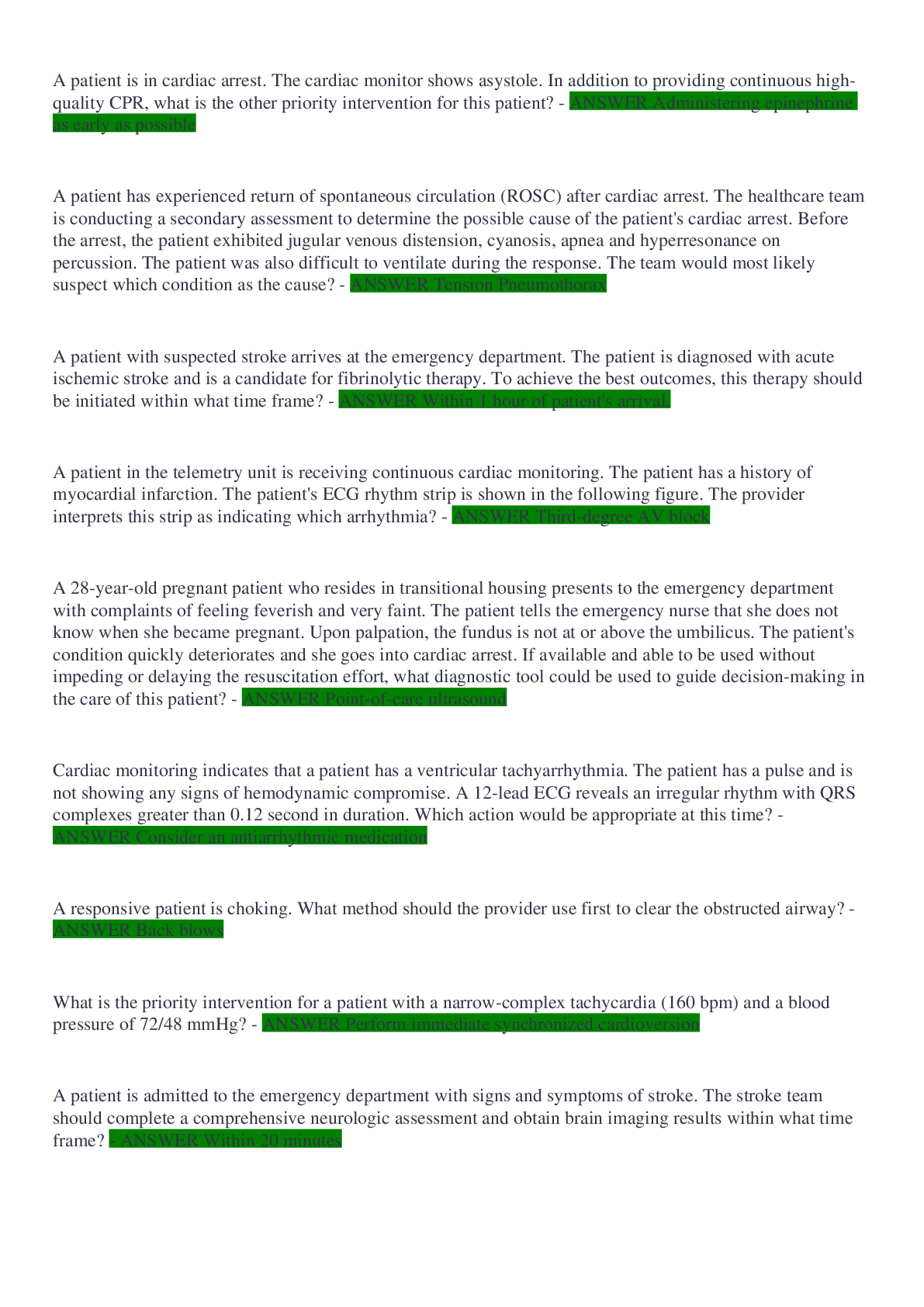
Reviews( 0 )
Document information
Connected school, study & course
About the document
Uploaded On
Aug 10, 2022
Number of pages
6
Written in
Additional information
This document has been written for:
Uploaded
Aug 10, 2022
Downloads
0
Views
91








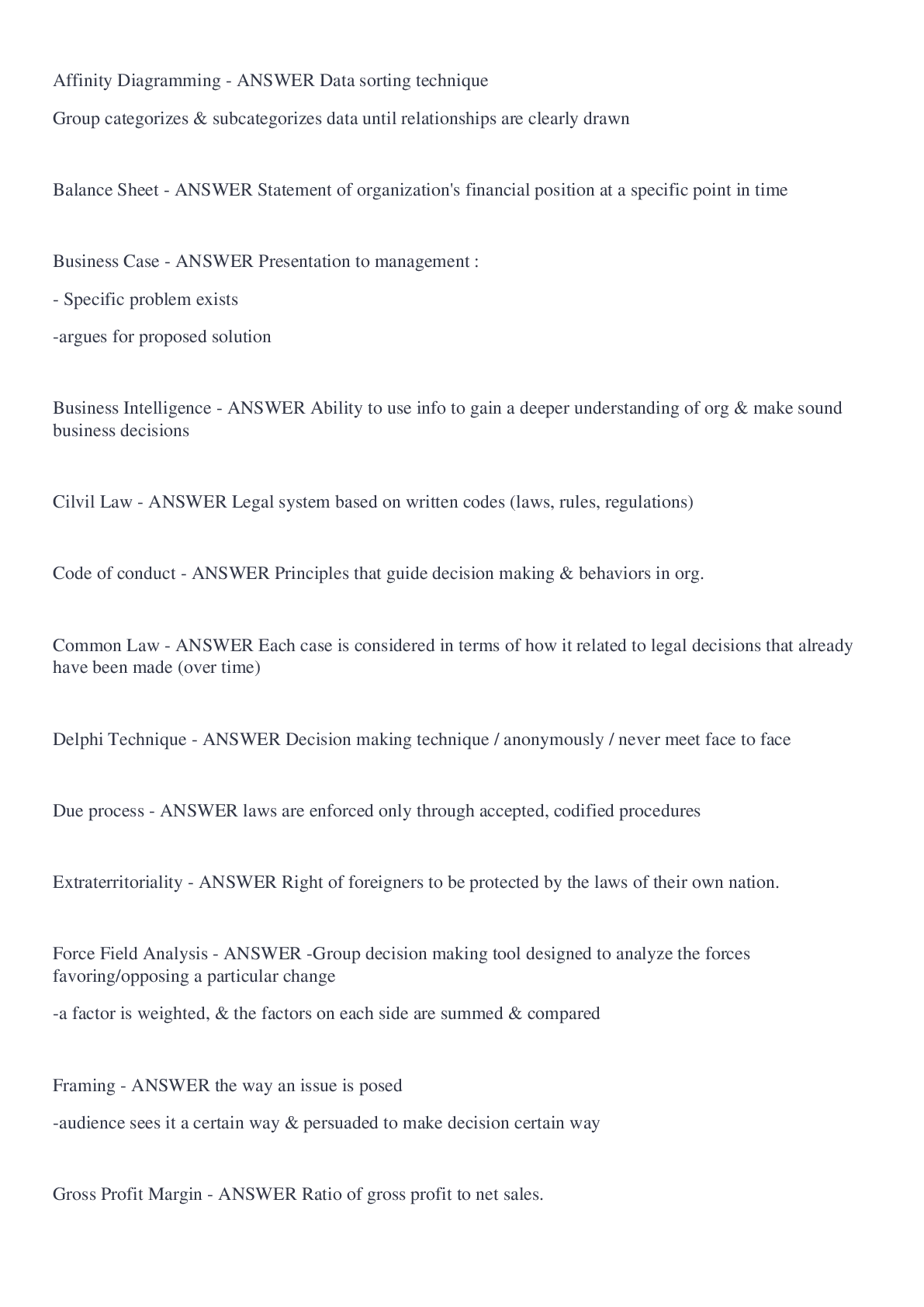

.png)


